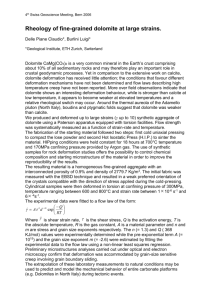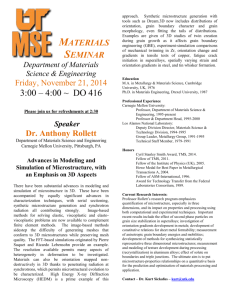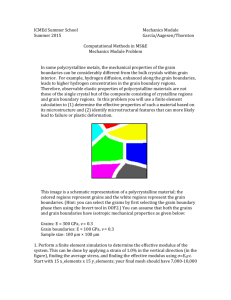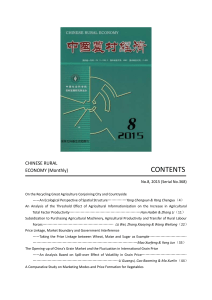Ebert_Andreas_Poster - SWISS GEOSCIENCE MEETINGs
advertisement
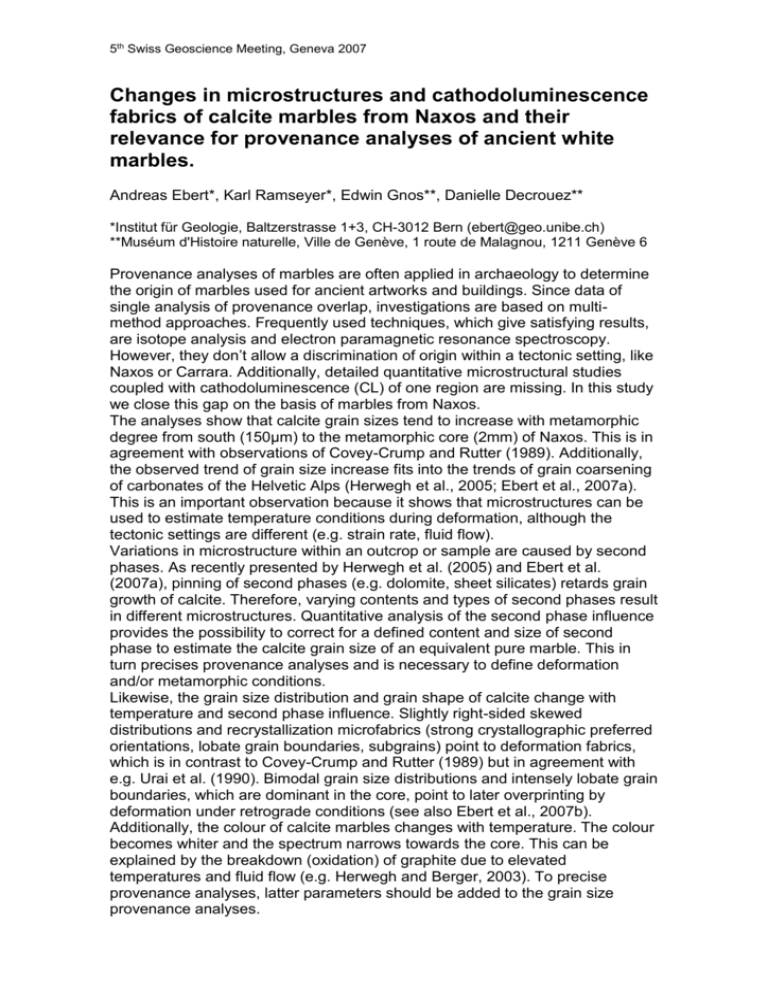
5th Swiss Geoscience Meeting, Geneva 2007 Changes in microstructures and cathodoluminescence fabrics of calcite marbles from Naxos and their relevance for provenance analyses of ancient white marbles. Andreas Ebert*, Karl Ramseyer*, Edwin Gnos**, Danielle Decrouez** *Institut für Geologie, Baltzerstrasse 1+3, CH-3012 Bern (ebert@geo.unibe.ch) **Muséum d'Histoire naturelle, Ville de Genève, 1 route de Malagnou, 1211 Genève 6 Provenance analyses of marbles are often applied in archaeology to determine the origin of marbles used for ancient artworks and buildings. Since data of single analysis of provenance overlap, investigations are based on multimethod approaches. Frequently used techniques, which give satisfying results, are isotope analysis and electron paramagnetic resonance spectroscopy. However, they don’t allow a discrimination of origin within a tectonic setting, like Naxos or Carrara. Additionally, detailed quantitative microstructural studies coupled with cathodoluminescence (CL) of one region are missing. In this study we close this gap on the basis of marbles from Naxos. The analyses show that calcite grain sizes tend to increase with metamorphic degree from south (150µm) to the metamorphic core (2mm) of Naxos. This is in agreement with observations of Covey-Crump and Rutter (1989). Additionally, the observed trend of grain size increase fits into the trends of grain coarsening of carbonates of the Helvetic Alps (Herwegh et al., 2005; Ebert et al., 2007a). This is an important observation because it shows that microstructures can be used to estimate temperature conditions during deformation, although the tectonic settings are different (e.g. strain rate, fluid flow). Variations in microstructure within an outcrop or sample are caused by second phases. As recently presented by Herwegh et al. (2005) and Ebert et al. (2007a), pinning of second phases (e.g. dolomite, sheet silicates) retards grain growth of calcite. Therefore, varying contents and types of second phases result in different microstructures. Quantitative analysis of the second phase influence provides the possibility to correct for a defined content and size of second phase to estimate the calcite grain size of an equivalent pure marble. This in turn precises provenance analyses and is necessary to define deformation and/or metamorphic conditions. Likewise, the grain size distribution and grain shape of calcite change with temperature and second phase influence. Slightly right-sided skewed distributions and recrystallization microfabrics (strong crystallographic preferred orientations, lobate grain boundaries, subgrains) point to deformation fabrics, which is in contrast to Covey-Crump and Rutter (1989) but in agreement with e.g. Urai et al. (1990). Bimodal grain size distributions and intensely lobate grain boundaries, which are dominant in the core, point to later overprinting by deformation under retrograde conditions (see also Ebert et al., 2007b). Additionally, the colour of calcite marbles changes with temperature. The colour becomes whiter and the spectrum narrows towards the core. This can be explained by the breakdown (oxidation) of graphite due to elevated temperatures and fluid flow (e.g. Herwegh and Berger, 2003). To precise provenance analyses, latter parameters should be added to the grain size provenance analyses. 5th Swiss Geoscience Meeting, Geneva 2007 The CL microfabrics also change along the sampled profile. The maximum CL intensity decreases continuously with rising temperatures but increases again in the zone of anatexis (metamorphic core of Naxos). The colour spectrum changes from yellow, orange, and blue colours in the south of Naxos to blueviolet colours, where intensities are the lowest, and reach again mainly intense orange colours in the core. Latter colours can be explained by metamorphic mineral reactions or migmatization resulting in higher fluid flow penetrating the fabrics and providing different ratios of Mn and Fe, which change the CL colour and intensity. Simultaneously to the change in CL intensity, the CL fabrics become more homogenous towards the core. The differences in CL intensity and fabrics depend of the dolomite content of the calcite marbles and the homogenization of microfabrics. Latter one is faster with increasing temperatures during deformation inducing faster diffusion processes and grain boundary mobility due to dynamic recrystallization. The investigations indicate that provenance analyses using the microstructure and CL fabric are possible. Furthermore, this helps to narrow down the origin within a region. In addition, we are now able to provide a good database of microstructures for geologists and archaeologists. Since we can interpret the variations of microstructures within an outcrop, the large grain size variations of Covey-Crump and Rutter (1989) for constant temperature conditions can be explained by the influence of second phases. REFERENCES Covey-Crump, S. J. & Rutter, E. H. 1989: Thermally-induced grain growth of calcite marbles on Naxos Island, Greece. Contributions to Mineralogy and Petrology 101(1), 69-86. Ebert, A., Herwegh, M., Evans, B., Pfiffner, A., Austin, N. & Vennemann, T. 2007a: Microfabrics in carbonate mylonites along a large-scale shear zone (Helvetic Alps). Tectonophysics In Press. Ebert, A., Herwegh, M. & Pfiffner, A. 2007b: Cooling induced strain localization in carbonate mylonites within a large-scale shear zone (Glarus thrust, Switzerland). Journal of Structural Geology 29(7), 1164-1184. Herwegh, M. & Berger, A. 2003: Differences in grain growth of calcite: a fieldbased modeling approach. Contributions to Mineralogy and Petrology 145(5), 600-611. Herwegh, M., Berger, A. & Ebert, A. 2005: Grain coarsening maps: A new tool to predict microfabric evolution of polymineralic rocks. Geology 33(10), 801-804. Urai, J.L., Schuiling, R.D. & Jansen, B.H. 1990: Alpine deformation on Naxos (Greece). Deformation mechanisms, rheology and tectonics. Geological Society Special Publications, London, 54, 509-522.

